Foundations of American Government.pptx
Download as pptx, pdf0 likes91 views
This document provides an overview of the key concepts of government and economics. It defines government as an institution that makes and enforces laws to maintain order. Governments provide public services, national security, and economic assistance. It also defines different types of political communities and origins of the state. The document outlines systems of government including unitary, confederate, and federal systems. It describes principles of democracy and different forms of government such as authoritarian, monarchy, and representative democracy. Finally, it defines and compares economic systems such as capitalism, socialism, mixed economies, and communism.
1 of 13
Download to read offline
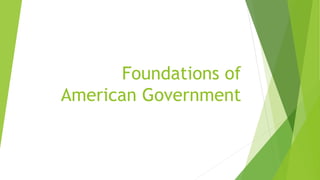
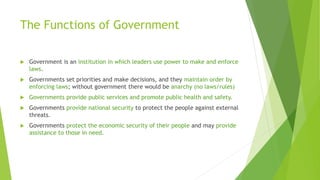
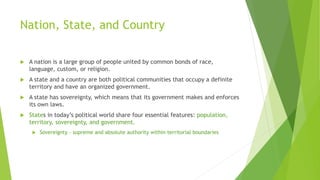
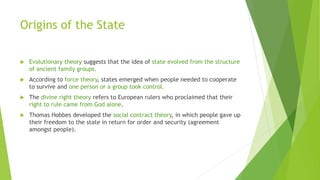
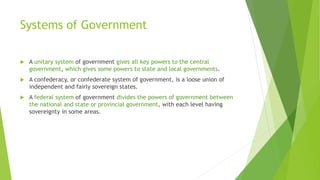
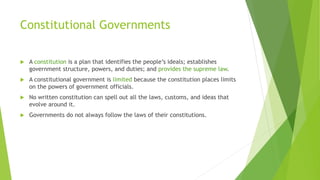
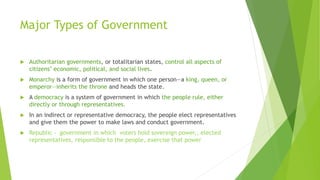
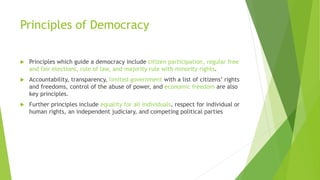
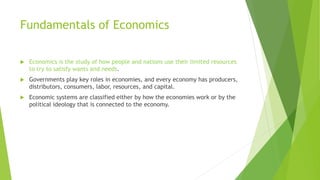


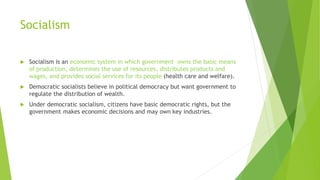

Ad
Recommended
Midterms Lesson Midterms Lesson Midterms Lesson 2.pptx
Midterms Lesson Midterms Lesson Midterms Lesson 2.pptxGavin Malala
╠²
There are several forms of government that differ in their structure and degree of control. Democracies give power to the people through elections, while monarchies are ruled by a single hereditary leader, such as a king or queen. Theocracies base their laws on religious doctrines and are governed by religious clergy. Dictatorships concentrate absolute power in the hands of a single ruler or party. Governments also differ in their economic systems, with capitalism granting private ownership, socialism providing public benefits, and communism giving the state control over production.Introduction to Government
Introduction to GovernmentTaylor Phillips
╠²
The document provides an introduction to key concepts in U.S. government, including definitions of government and its purposes to unite citizens, provide justice and security, and ensure citizens' well-being. It describes the three powers of government as legislative, executive, and judicial. It also outlines four theories of the origin of the state and different forms of government like democracy, dictatorship, and how a government can be organized at national and local levels.1[1].foundations of american government
1[1].foundations of american governmentjtoma84
╠²
This document provides an overview of the foundations of American government. It discusses the origins of democracy in ancient Greece and republican government in ancient Rome. Representative democracy and the US system of government are modeled after the Roman republic. The document also covers the essential features of a state, including population, territory, sovereignty, and government. It defines different forms of government such as democracy, republic, autocracy, and oligarchy. Additionally, it discusses the role of economic systems like capitalism and socialism in governing societies.formsofgovernment-100827015740-phpapp01.pptx
formsofgovernment-100827015740-phpapp01.pptxyolandamyers1
╠²
The document explains the concept of government as a system of social control with varying forms, including democracy, monarchy, theocracy, and dictatorship, each characterized by different power structures and levels of control. It also discusses economic systems, namely capitalism, socialism, and communism, highlighting their distinct characteristics and the degree of government involvement in economic activities. Additionally, it notes that totalitarianism represents an extreme form of governmental control over people's lives.1[1].foundations of american government
1[1].foundations of american governmentjtoma84
╠²
The document provides an overview of key concepts in American government including the purposes of government, different types of governments and economic systems. It discusses how governments originated in ancient Greece and how the US government derives its power from the Constitution. It also summarizes different forms of government such as democracy, republic and authoritarian rule, and economic systems including capitalism, socialism and communism.HSA Review: Units One And Two
HSA Review: Units One And Twobilly_shulman
╠²
The document discusses different forms of government and economic systems. It begins by defining confederacy, unitary, and federal forms of government based on how power is distributed. It then discusses types of democracies like direct vs. representative and presidential vs. parliamentary. The document also covers unlimited governments including monarchies, dictatorships, oligarchies, and totalitarian systems. It defines traditional, command, market, and mixed market economies and explains how economic decisions are made in each. It concludes by reviewing principles of the US Constitution such as popular sovereignty, federalism, rule of law, separation of powers, checks and balances, and judicial review.Government
GovernmentBo Chamberlain
╠²
This document discusses different forms of government. It defines government as a group that determines how a country operates and provides security and services. There are many types that differ in citizens' level of power, including democracy (rule by citizens directly or through elected representatives), autocracy (rule by a single leader), oligarchy (rule by a small privileged group), monarchy (rule by a king or queen), communism (rule by a communist party that owns economic resources), and socialism (government controls some businesses and property to spread wealth). Federalism divides power between national and state governments.Lesson #3: The Political Economy
Lesson #3: The Political Economygravy503
╠²
This document discusses different political and economic systems including liberal political economy, regulated capitalism, mercantilism, Marxism, communism, and socialist democracies. It provides definitions and explanations of key concepts such as how political systems interact with economic systems in the study of political economy, and different views on trade, private ownership, and the role of government in economic planning.Forms of government
Forms of governmentrenaoregan
╠²
This document provides information about different forms of government. It discusses democracy, monarchy, theocracy, dictatorship, and transitional governments. It also covers different economic systems like capitalism, socialism, and communism. Modern governments take on roles like providing security, justice, welfare services, and education. Extreme governmental control is called totalitarianism. The document gives examples of different forms of government and economic systems around the world.Forms of government
Forms of governmentparrym
╠²
Government is a system that gives a group the right to make and enforce laws. There are different forms of government based on who holds power and the structure of rule. Modern governments have roles like security, order, justice, welfare, regulation, and education. The main forms discussed are democracy, monarchy, theocracy, and dictatorship. Democracy gives supreme power to citizens through representation or direct voting. A monarchy has rule by a hereditary monarch, while a theocracy bases law on religion. A dictatorship concentrates absolute power in one leader. Economic systems like capitalism, socialism, and communism are also discussed in how private ownership and government control of production differ.Forms of Government
Forms of Governmentrenaoregan
╠²
Government is a system that gives a group the right to make and enforce laws. There are different forms of government based on who holds power and the structure of rule. Modern governments have roles like security, order, justice, welfare, regulation, and education. The main forms discussed are democracy, monarchy, theocracy, and dictatorship. Democracy gives supreme power to citizens through representation or direct voting. A monarchy has a hereditary ruler like a king or queen, while a theocracy bases its laws on religion. A dictatorship concentrates absolute power in one leader or party. Economic systems like capitalism, socialism, and communism are also discussed in how businesses and resources are owned and distributed.Forms of government
Forms of governmentTriciaMowat
╠²
Government is a system that gives a group the right to make and enforce laws. There are different forms of government based on who holds power and the structure of rule. Modern governments have roles like security, order, justice, welfare, regulation, and education. The main forms are democracy, monarchy, theocracy, and dictatorship. Democracy gives supreme power to citizens through representation or direct voting. A monarchy has rule by a hereditary monarch, while a theocracy bases law on religion. A dictatorship concentrates absolute power in one leader. Economic systems like capitalism, socialism, and communism are also connected to governments. Capitalism allows private business ownership, socialism involves some government control of business, and communism gives the government control of allChapter 2 National Differences in Political Economy by Islam El-Shafie
Chapter 2 National Differences in Political Economy by Islam El-ShafieIslam El-Shafie
╠²
This document discusses how the political, economic, and legal systems of a country are interdependent and influence each other. It defines key concepts like political systems, collectivism vs individualism, democracy vs totalitarianism, and different types of economic and legal systems. The political ideology of a country influences its economic system - countries that emphasize individual goals tend to have market economies while more collectivist countries favor more state ownership. The legal system also affects how business is conducted and contracts are enforced. Managers should consider these national differences in political economy when assessing a foreign market's overall attractiveness.INB 372 national difference in political economy lecture topic 2.ppt
INB 372 national difference in political economy lecture topic 2.pptssuserbea996
╠²
This document discusses political economies and how they differ between nations. It defines key terms like political system, collectivism, individualism, democracy, totalitarianism, and economic systems. It examines the legal and intellectual property systems and how property rights and corruption are related. Managers can assess a market's attractiveness by balancing benefits, costs and risks based on factors like its political institutions, economic system, and strength of legal protections.Forms of Government and Economic Systems
Forms of Government and Economic SystemsFerenKristen
╠²
Government is a system that gives a group the right to make and enforce laws. There are different forms of government based on who holds power and the structure used. Modern governments have roles like security, order, justice, welfare, regulation, and education. The main forms discussed are democracy, monarchy, theocracy, and dictatorship. Democracy gives supreme power to citizens through representation or direct voting. A monarchy has a hereditary ruler like a king or queen, while a theocracy bases its laws on religion. A dictatorship concentrates power in one leader or party. Economic systems like capitalism, socialism, and communism are also discussed in relation to different forms of government.Political business analysis Dr. Sihem Bouguila
Political business analysis Dr. Sihem Bouguilaboufersen
╠²
Democracy is a system of government where citizens have power directly or through elected representatives. Key aspects include majority rule and no single entity controlling outcomes. Democracy originated in ancient Greek and Roman city-states and the modern concept developed in Western nations. Examples of highly rated democracies today include Norway, Iceland, Sweden and others.Presentation1 intro to Gov
Presentation1 intro to Govcheid
╠²
The document summarizes the key purposes and features of government. It discusses maintaining social order, providing public services, providing security and defense, and providing for the economy as the four primary purposes of government. It also outlines the four essential features of a state as population, territory, sovereignty, and government. Finally, it briefly introduces several theories around the origins of the state, including evolutionary theory, force theory, and social contract theory.CRCT vocab 2 government and economics
CRCT vocab 2 government and economicspatrick_pitts
╠²
The document provides warm up questions and answers for students about economic systems, forms of government, and factors of production. It discusses different types of economic systems like traditional economies, command economies, and free market economies. It also outlines forms of government such as unitary, confederation, and federal systems. Additionally, it defines the four factors of production as land, labor, capital, and entrepreneurship. The document serves as a study guide for social studies concepts.Forms of Government - ppt on ideologies of different government structures
Forms of Government - ppt on ideologies of different government structuresJonathanFerguson31
╠²
The document outlines various forms of government, including their political and economic ideologies, advantages, disadvantages, and examples. It categorizes governments into authoritarian systems like dictatorship and theocracy, and democratic systems such as democracy and oligarchy, while also comparing economic ideologies like communism, capitalism, and socialism. Additionally, it encourages readers to conceptualize their own country by selecting a government type and characteristics.Political and economic institution
Political and economic institutionMussawerMkd
╠²
Political and economic institutions are the organizations that help govern society. Political institutions create and enforce laws through bodies like governments, parties, and heads of state. There are different types of political systems including democracy, republics, monarchies, and dictatorships. Economic institutions can be specific agencies that study the economy or established structures like property rights and free markets. Both political and economic institutions aim to maintain stability and order in society through rules and processes.Political and economic systems 4 3
Political and economic systems 4 3Tisha McCoy Bronikowski
╠²
This document discusses different types of political and economic systems. It defines a government and its main functions, and describes how power can be divided through unitary, federal, and confederation systems. It then examines forms of government including autocracy, oligarchy, and democracy. Finally, it outlines traditional, market, and command economic systems based on how goods are produced and distributed.Unit 2 government and trade academic
Unit 2 government and trade academicFredrick Smith
╠²
The document provides an overview of United States federal government spending, revenues, budgets, fiscal policy, deficits, debt, taxes, and the global economic landscape. It notes that mandatory spending on programs like Social Security and discretionary spending on defense constitute a large portion of the federal budget. It also discusses fiscal policy tools like spending and taxation used to influence the economy, as well as the deficits, debt, and borrowing that occur when expenditures exceed revenues. The document concludes with a brief discussion of international trade, development levels in different countries, and economic situations in regions like Africa, China, and India.Topic 1
Topic 1ShoaibKhan539
╠²
This document provides an overview of key concepts related to political economies and national differences. It discusses what political, economic, and legal systems are and how they interact. It also examines different types of systems such as collectivism vs individualism, democracy vs totalitarianism, and market vs command vs mixed economies. The document then analyzes how these various factors can influence a country's level of economic development and compares economic data across different nations.Economic Systems
Economic SystemsVilla Santa Maria
╠²
The document compares different types of economic systems: traditional, free market, command, and mixed. It defines each system and provides examples. A traditional economy relies on customs and family ownership. A free market economy uses supply and demand with minimal government. A command economy has the government control production and distribution. Most countries now use a mixed economy with public and private aspects.Government ch. 1 - principles of gov't
Government ch. 1 - principles of gov'tBrighton Alternative
╠²
1. A state is defined as a political community that occupies a territory and has an organized government with the power to make and enforce laws without approval from any higher authority. The document discusses the essential features of a state including population, territory, sovereignty, and government.
2. Governments derive their power through legitimacy, with the consent of the governed, and through their ability to use coercive force. Government systems can be unitary, with all power centralized in the national government, or federal, with power divided between national and subnational governments.
3. Constitutions are plans that provide the rules for governments, establishing their structure, describing a country's ideals, and acting as the supreme law of the land.Government ch. 1 - principles of gov't (1)
Government ch. 1 - principles of gov't (1)Brighton Alternative
╠²
1. A state is defined as a political community that occupies a territory and has an organized government with the power to make and enforce laws without approval from any higher authority. The document discusses the essential features of a state including population, territory, sovereignty, and government.
2. Governments derive their power through legitimacy, or the consent of the governed, as well as through their ability to use coercive force. Government systems can be unitary, with all power centralized in the national government, or federal, with power divided between national and subnational governments.
3. Constitutions are plans that provide the rules for governments, describing a country's ideals, establishing the government structure, and acting as the supreme law ofChap002.ppt waqas asghar ali published s
Chap002.ppt waqas asghar ali published sWaqasAsgharGoraya
╠²
Chapter 2 of 'International Business' by Charles W.L. Hill outlines the interdependence of political, economic, and legal systems within a nation's political economy, highlighting the differences between collectivism and individualism. It explains political systems such as democracy and totalitarianism, various economic systems, and legal frameworks that govern contracts and property rights. The chapter further discusses how political economy influences economic development and the impact of market transitions on managerial strategies in international business.Ch1: Foundation of Government
Ch1: Foundation of Government rickerkristen
╠²
This document provides an overview of key concepts in American government, including definitions of government, democracy, and federalism. It describes the origins of government in human societies and early contributions from Greek and Roman civilizations. The document also discusses why studying government is important, the purposes of the US government outlined in the Constitution, different forms of government classification, and the relationship between democracy and free enterprise systems.june 10 2025 ppt for madden on art science is over.pptx
june 10 2025 ppt for madden on art science is over.pptxroger malina
╠²
art science is over -talk by roger malina for jack madden groupMore Related Content
Similar to Foundations of American Government.pptx (20)
Forms of government
Forms of governmentrenaoregan
╠²
This document provides information about different forms of government. It discusses democracy, monarchy, theocracy, dictatorship, and transitional governments. It also covers different economic systems like capitalism, socialism, and communism. Modern governments take on roles like providing security, justice, welfare services, and education. Extreme governmental control is called totalitarianism. The document gives examples of different forms of government and economic systems around the world.Forms of government
Forms of governmentparrym
╠²
Government is a system that gives a group the right to make and enforce laws. There are different forms of government based on who holds power and the structure of rule. Modern governments have roles like security, order, justice, welfare, regulation, and education. The main forms discussed are democracy, monarchy, theocracy, and dictatorship. Democracy gives supreme power to citizens through representation or direct voting. A monarchy has rule by a hereditary monarch, while a theocracy bases law on religion. A dictatorship concentrates absolute power in one leader. Economic systems like capitalism, socialism, and communism are also discussed in how private ownership and government control of production differ.Forms of Government
Forms of Governmentrenaoregan
╠²
Government is a system that gives a group the right to make and enforce laws. There are different forms of government based on who holds power and the structure of rule. Modern governments have roles like security, order, justice, welfare, regulation, and education. The main forms discussed are democracy, monarchy, theocracy, and dictatorship. Democracy gives supreme power to citizens through representation or direct voting. A monarchy has a hereditary ruler like a king or queen, while a theocracy bases its laws on religion. A dictatorship concentrates absolute power in one leader or party. Economic systems like capitalism, socialism, and communism are also discussed in how businesses and resources are owned and distributed.Forms of government
Forms of governmentTriciaMowat
╠²
Government is a system that gives a group the right to make and enforce laws. There are different forms of government based on who holds power and the structure of rule. Modern governments have roles like security, order, justice, welfare, regulation, and education. The main forms are democracy, monarchy, theocracy, and dictatorship. Democracy gives supreme power to citizens through representation or direct voting. A monarchy has rule by a hereditary monarch, while a theocracy bases law on religion. A dictatorship concentrates absolute power in one leader. Economic systems like capitalism, socialism, and communism are also connected to governments. Capitalism allows private business ownership, socialism involves some government control of business, and communism gives the government control of allChapter 2 National Differences in Political Economy by Islam El-Shafie
Chapter 2 National Differences in Political Economy by Islam El-ShafieIslam El-Shafie
╠²
This document discusses how the political, economic, and legal systems of a country are interdependent and influence each other. It defines key concepts like political systems, collectivism vs individualism, democracy vs totalitarianism, and different types of economic and legal systems. The political ideology of a country influences its economic system - countries that emphasize individual goals tend to have market economies while more collectivist countries favor more state ownership. The legal system also affects how business is conducted and contracts are enforced. Managers should consider these national differences in political economy when assessing a foreign market's overall attractiveness.INB 372 national difference in political economy lecture topic 2.ppt
INB 372 national difference in political economy lecture topic 2.pptssuserbea996
╠²
This document discusses political economies and how they differ between nations. It defines key terms like political system, collectivism, individualism, democracy, totalitarianism, and economic systems. It examines the legal and intellectual property systems and how property rights and corruption are related. Managers can assess a market's attractiveness by balancing benefits, costs and risks based on factors like its political institutions, economic system, and strength of legal protections.Forms of Government and Economic Systems
Forms of Government and Economic SystemsFerenKristen
╠²
Government is a system that gives a group the right to make and enforce laws. There are different forms of government based on who holds power and the structure used. Modern governments have roles like security, order, justice, welfare, regulation, and education. The main forms discussed are democracy, monarchy, theocracy, and dictatorship. Democracy gives supreme power to citizens through representation or direct voting. A monarchy has a hereditary ruler like a king or queen, while a theocracy bases its laws on religion. A dictatorship concentrates power in one leader or party. Economic systems like capitalism, socialism, and communism are also discussed in relation to different forms of government.Political business analysis Dr. Sihem Bouguila
Political business analysis Dr. Sihem Bouguilaboufersen
╠²
Democracy is a system of government where citizens have power directly or through elected representatives. Key aspects include majority rule and no single entity controlling outcomes. Democracy originated in ancient Greek and Roman city-states and the modern concept developed in Western nations. Examples of highly rated democracies today include Norway, Iceland, Sweden and others.Presentation1 intro to Gov
Presentation1 intro to Govcheid
╠²
The document summarizes the key purposes and features of government. It discusses maintaining social order, providing public services, providing security and defense, and providing for the economy as the four primary purposes of government. It also outlines the four essential features of a state as population, territory, sovereignty, and government. Finally, it briefly introduces several theories around the origins of the state, including evolutionary theory, force theory, and social contract theory.CRCT vocab 2 government and economics
CRCT vocab 2 government and economicspatrick_pitts
╠²
The document provides warm up questions and answers for students about economic systems, forms of government, and factors of production. It discusses different types of economic systems like traditional economies, command economies, and free market economies. It also outlines forms of government such as unitary, confederation, and federal systems. Additionally, it defines the four factors of production as land, labor, capital, and entrepreneurship. The document serves as a study guide for social studies concepts.Forms of Government - ppt on ideologies of different government structures
Forms of Government - ppt on ideologies of different government structuresJonathanFerguson31
╠²
The document outlines various forms of government, including their political and economic ideologies, advantages, disadvantages, and examples. It categorizes governments into authoritarian systems like dictatorship and theocracy, and democratic systems such as democracy and oligarchy, while also comparing economic ideologies like communism, capitalism, and socialism. Additionally, it encourages readers to conceptualize their own country by selecting a government type and characteristics.Political and economic institution
Political and economic institutionMussawerMkd
╠²
Political and economic institutions are the organizations that help govern society. Political institutions create and enforce laws through bodies like governments, parties, and heads of state. There are different types of political systems including democracy, republics, monarchies, and dictatorships. Economic institutions can be specific agencies that study the economy or established structures like property rights and free markets. Both political and economic institutions aim to maintain stability and order in society through rules and processes.Political and economic systems 4 3
Political and economic systems 4 3Tisha McCoy Bronikowski
╠²
This document discusses different types of political and economic systems. It defines a government and its main functions, and describes how power can be divided through unitary, federal, and confederation systems. It then examines forms of government including autocracy, oligarchy, and democracy. Finally, it outlines traditional, market, and command economic systems based on how goods are produced and distributed.Unit 2 government and trade academic
Unit 2 government and trade academicFredrick Smith
╠²
The document provides an overview of United States federal government spending, revenues, budgets, fiscal policy, deficits, debt, taxes, and the global economic landscape. It notes that mandatory spending on programs like Social Security and discretionary spending on defense constitute a large portion of the federal budget. It also discusses fiscal policy tools like spending and taxation used to influence the economy, as well as the deficits, debt, and borrowing that occur when expenditures exceed revenues. The document concludes with a brief discussion of international trade, development levels in different countries, and economic situations in regions like Africa, China, and India.Topic 1
Topic 1ShoaibKhan539
╠²
This document provides an overview of key concepts related to political economies and national differences. It discusses what political, economic, and legal systems are and how they interact. It also examines different types of systems such as collectivism vs individualism, democracy vs totalitarianism, and market vs command vs mixed economies. The document then analyzes how these various factors can influence a country's level of economic development and compares economic data across different nations.Economic Systems
Economic SystemsVilla Santa Maria
╠²
The document compares different types of economic systems: traditional, free market, command, and mixed. It defines each system and provides examples. A traditional economy relies on customs and family ownership. A free market economy uses supply and demand with minimal government. A command economy has the government control production and distribution. Most countries now use a mixed economy with public and private aspects.Government ch. 1 - principles of gov't
Government ch. 1 - principles of gov'tBrighton Alternative
╠²
1. A state is defined as a political community that occupies a territory and has an organized government with the power to make and enforce laws without approval from any higher authority. The document discusses the essential features of a state including population, territory, sovereignty, and government.
2. Governments derive their power through legitimacy, with the consent of the governed, and through their ability to use coercive force. Government systems can be unitary, with all power centralized in the national government, or federal, with power divided between national and subnational governments.
3. Constitutions are plans that provide the rules for governments, establishing their structure, describing a country's ideals, and acting as the supreme law of the land.Government ch. 1 - principles of gov't (1)
Government ch. 1 - principles of gov't (1)Brighton Alternative
╠²
1. A state is defined as a political community that occupies a territory and has an organized government with the power to make and enforce laws without approval from any higher authority. The document discusses the essential features of a state including population, territory, sovereignty, and government.
2. Governments derive their power through legitimacy, or the consent of the governed, as well as through their ability to use coercive force. Government systems can be unitary, with all power centralized in the national government, or federal, with power divided between national and subnational governments.
3. Constitutions are plans that provide the rules for governments, describing a country's ideals, establishing the government structure, and acting as the supreme law ofChap002.ppt waqas asghar ali published s
Chap002.ppt waqas asghar ali published sWaqasAsgharGoraya
╠²
Chapter 2 of 'International Business' by Charles W.L. Hill outlines the interdependence of political, economic, and legal systems within a nation's political economy, highlighting the differences between collectivism and individualism. It explains political systems such as democracy and totalitarianism, various economic systems, and legal frameworks that govern contracts and property rights. The chapter further discusses how political economy influences economic development and the impact of market transitions on managerial strategies in international business.Ch1: Foundation of Government
Ch1: Foundation of Government rickerkristen
╠²
This document provides an overview of key concepts in American government, including definitions of government, democracy, and federalism. It describes the origins of government in human societies and early contributions from Greek and Roman civilizations. The document also discusses why studying government is important, the purposes of the US government outlined in the Constitution, different forms of government classification, and the relationship between democracy and free enterprise systems.Recently uploaded (20)
june 10 2025 ppt for madden on art science is over.pptx
june 10 2025 ppt for madden on art science is over.pptxroger malina
╠²
art science is over -talk by roger malina for jack madden groupGEOGRAPHY-Study Material [ Class 10th] .pdf
GEOGRAPHY-Study Material [ Class 10th] .pdfSHERAZ AHMAD LONE
╠²
"Geography Study Material for Class 10th" provides a comprehensive and easy-to-understand resource for key topics like Resources & Development, Water Resources, Agriculture, Minerals & Energy, Manufacturing Industries, and Lifelines of the National Economy. Designed as per the latest NCERT/JKBOSE syllabus, it includes notes, maps, diagrams, and MODEL question Paper to help students excel in exams. Whether revising for exams or strengthening conceptual clarity, this material ensures effective learning and high scores. Perfect for last-minute revisions and structured study sessions.Plate Tectonic Boundaries and Continental Drift Theory
Plate Tectonic Boundaries and Continental Drift TheoryMarie
╠²
This 28 slide presentation covers the basics of plate tectonics and continental drift theory. It is an effective introduction into a full plate tectonics unit study, but does not cover faults, stress, seismic waves, or seafloor spreading.
To download PDF, visit The Homeschool Daily. We will be uploading more slideshows to follow this one. Blessings, Marie Overview of Employee in Odoo 18 - Odoo ║▌║▌▀Żs
Overview of Employee in Odoo 18 - Odoo ║▌║▌▀ŻsCeline George
╠²
The employee module is a core component of the HR workspace that helps the business to get the employee activities and details. This would also allow you to get the employee details by acting as a centralized system and accessing, updating, and managing all the other employee data. Battle of Bookworms 2025 - U25 Literature Quiz by Pragya
Battle of Bookworms 2025 - U25 Literature Quiz by Pragya Pragya - UEM Kolkata Quiz Club
╠²
Battle of Bookworms is a literature quiz organized by Pragya, UEM Kolkata, as part of their cultural fest Ecstasia. Curated by quizmasters Drisana Bhattacharyya, Argha Saha, and Aniket Adhikari, the quiz was a dynamic mix of classical literature, modern writing, mythology, regional texts, and experimental literary forms. It began with a 20-question prelim round where ŌĆśstar questionsŌĆÖ played a key tie-breaking role. The top 8 teams moved into advanced rounds, where they faced audio-visual challenges, pounce/bounce formats, immunity tokens, and theme-based risk-reward questions. From Orwell and Hemingway to Tagore and Sarala Das, the quiz traversed a global and Indian literary landscape. Unique rounds explored slipstream fiction, constrained writing, adaptations, and true crime literature. It included signature IDs, character identifications, and open-pounce selections. Questions were crafted to test contextual understanding, narrative knowledge, and authorial intent, making the quiz both intellectually rewarding and culturally rich. Battle of Bookworms proved literature quizzes can be insightful, creative, and deeply enjoyable for all.LDMMIA GRAD Student Check-in Orientation Sampler
LDMMIA GRAD Student Check-in Orientation SamplerLDM & Mia eStudios
╠²
Completed Tuesday June 10th.
An Orientation Sampler of 8 pages.
It helps to understand the text behind anything. This improves our performance and confidence.
Your training will be mixed media. Includes Rehab Intro and Meditation vods, all sold separately.
Editing our Vods & New Shop.
Retail under $30 per item. Store Fees will apply. Digital Should be low cost.
I am still editing the package. I wont be done until probably July? However; Orientation and Lecture 1 (Videos) will be available soon. Media will vary between PDF and Instruction Videos.
Thank you for attending our free workshops. Those can be used with any Reiki Yoga training package. Traditional Reiki does host rules and ethics. Its silent and within the JP Culture/Area/Training/Word of Mouth. It allows remote healing but thereŌĆÖs limits for practitioners and masters. We are not allowed to share certain secrets/tools. Some content is designed only for ŌĆ£MastersŌĆØ. Some yoga are similar like the Kriya Yoga-Church (Vowed Lessons). We will review both Reiki and Yoga (Master symbols) later on. Sounds Simple but these things host Energy Power/Protection.
Imagine This package will be a supplement or upgrade for professional Reiki. You can create any style you need.
ŌÖźŌÖźŌÖź
ŌĆó* ╠ü ╠ł ╠¦.ŌĆó
(Job) Tech for students: In short, high speed is essential. (Space, External Drives, virtual clouds)
Fast devices and desktops are important. Please upgrade your technology and office as needed and timely. - MIA J. Tech Dept (Timeless)
ŌÖźŌÖźŌÖź
ŌĆó* ╠ü ╠ł ╠¦.ŌĆó
Copyright Disclaimer 2007-2025+: These lessons are not to be copied or revised without the
AuthorŌĆÖs permission. These Lessons are designed Rev. Moore to instruct and guide students on the path to holistic health and wellness.
ItŌĆÖs about expanding your Nature Talents, gifts, even Favorite Hobbies.
ŌÖźŌÖźŌÖź
ŌĆó* ╠ü ╠ł ╠¦.ŌĆó
First, Society is still stuck in the matrix. Many of the spiritual collective, say the matrix crashed. Its now collapsing. This means anything lower, darker realms, astral, and matrix are below 5D. 5D is thee trend. ItŌĆÖs our New Dimensional plane. However; this plane takes work ethic,
integration, and self discovery. ŌÖźŌÖźŌÖź
ŌĆó* ╠ü ╠ł ╠¦.ŌĆó
We donŌĆÖt need to slave, mule, or work double shifts to fuse Reiki lol. It should blend naturally within our lifestyles. Same with Yoga. ThereŌĆÖs no
need to use all the poses/asanas. For under a decade, my fav exercises are not asanas but Pilates. ItŌĆÖs all about Yoga-meditation when using Reiki. (Breaking old myths.)
Thank You for reading our Orientation Sampler. The Workshop is 14 pages on introduction. These are a joy and effortless to produce/make.Ray Dalio How Countries go Broke the Big Cycle
Ray Dalio How Countries go Broke the Big CycleDadang Solihin
╠²
A complete and practical understanding of the Big Debt Cycle. A much more practical understanding of how supply and demand really work compared to the conventional economic thinking. A complete and practical understanding of the Overall Big Cycle, which is driven by the Big Debt Cycle and the other major cycles, including the big political cycle within countries that changes political orders and the big geopolitical cycle that changes world orders.PEST OF WHEAT SORGHUM BAJRA and MINOR MILLETS.pptx
PEST OF WHEAT SORGHUM BAJRA and MINOR MILLETS.pptxArshad Shaikh
╠²
Wheat, sorghum, and bajra (pearl millet) are susceptible to various pests that can significantly impact crop yields. Common pests include aphids, stem borers, shoot flies, and armyworms. Aphids feed on plant sap, weakening the plants, while stem borers and shoot flies damage the stems and shoots, leading to dead hearts and reduced growth. Armyworms, on the other hand, are voracious feeders that can cause extensive defoliation and grain damage. Effective management strategies, including resistant varieties, cultural practices, and targeted pesticide applications, are essential to mitigate pest damage and ensure healthy crop production.Measuring, learning and applying multiplication facts.
Measuring, learning and applying multiplication facts.cgilmore6
╠²
║▌║▌▀Żs from a presentation by Professor Camilla Gilmore to the Association of Teachers of Mathematics and Mathematics Association Primary Interest group in June 2025.
This gave an overview of two studies that investigated children's multiplication fact knowledge. These studies were part of the SUM research project based at the University of Nottingham and Loughborough University. For more information see www.sumproject.org.ukHow to Implement Least Package Removal Strategy in Odoo 18 Inventory
How to Implement Least Package Removal Strategy in Odoo 18 InventoryCeline George
╠²
In Odoo, the least package removal strategy is a feature designed to optimize inventory management by minimizing the number of packages open to fulfill the orders. This strategy is particularly useful for the business that deals with products packages in various quantities such as boxes, cartons or palettes. Energy Balances Of Oecd Countries 2011 Iea Statistics 1st Edition Oecd
Energy Balances Of Oecd Countries 2011 Iea Statistics 1st Edition Oecdrazelitouali
╠²
Energy Balances Of Oecd Countries 2011 Iea Statistics 1st Edition Oecd
Energy Balances Of Oecd Countries 2011 Iea Statistics 1st Edition Oecd
Energy Balances Of Oecd Countries 2011 Iea Statistics 1st Edition OecdUnit- 4 Biostatistics & Research Methodology.pdf
Unit- 4 Biostatistics & Research Methodology.pdfKRUTIKA CHANNE
╠²
Blocking and confounding (when a third variable, or confounder, influences both the exposure and the outcome) system for Two-level factorials (a type of experimental design where each factor (independent variable) is investigated at only two levels, typically denoted as "high" and "low" or "+1" and "-1")
Regression modeling (statistical model that estimates the relationship between one dependent variable and one or more independent variables using a line): Hypothesis testing in Simple and Multiple regression models
Introduction to Practical components of Industrial and Clinical Trials Problems: Statistical Analysis Using Excel, SPSS, MINITAB┬«’ĖÅ, DESIGN OF EXPERIMENTS, R - Online Statistical Software to Industrial and Clinical trial approachHow to Create an Event in Odoo 18 - Odoo 18 ║▌║▌▀Żs
How to Create an Event in Odoo 18 - Odoo 18 ║▌║▌▀ŻsCeline George
╠²
Creating an event in Odoo 18 is a straightforward process that allows you to manage various aspects of your event efficiently.
Odoo 18 Events Module is a powerful tool for organizing and managing events of all sizes, from conferences and workshops to webinars and meetups. Publishing Your Memoir with Brooke Warner
Publishing Your Memoir with Brooke WarnerBrooke Warner
╠²
Brooke Warner presents on getting published - traditional, hybrid, and self-publishing.
www.memoirnation.comICT-8-Module-REVISED-K-10-CURRICULUM.pdf
ICT-8-Module-REVISED-K-10-CURRICULUM.pdfpenafloridaarlyn
╠²
In this module, you will discover how digital tools, systems, and platforms empower people, businesses, and communities in the modern world. As 21st-century learners, you are part of a generation that lives and learns in a digital environment. This module is designed to guide you in exploring how ICT serves as a powerful toolŌĆönot only for communication but also for innovation, entrepreneurship, and responsible citizenship. Throughout this learning material, you will examine how ICT is used in real-world scenarios such as online marketing, digital citizenship, and legal and ethical issues in technology use. YouŌĆÖll gain practical knowledge and skills, from creating websites and managing e-commerce platforms, to analyzing data and practicing safe and responsible behavior online.
By engaging with the lessons, activities, and performance tasks in this module, you will become more than just a technology userŌĆöyou will be a responsible, informed, and empowered digital citizen ready to thrive in todayŌĆÖs interconnected world.
LetŌĆÖs begin this journey and unlock the full potential of ICT in your everyday life!
How to Manage & Create a New Department in Odoo 18 Employee
How to Manage & Create a New Department in Odoo 18 EmployeeCeline George
╠²
In Odoo 18's Employee module, organizing your workforce into departments enhances management and reporting efficiency. Departments are a crucial organizational unit within the Employee module.Chalukyas of Gujrat, Solanki Dynasty NEP.pptx
Chalukyas of Gujrat, Solanki Dynasty NEP.pptxDr. Ravi Shankar Arya Mahila P. G. College, Banaras Hindu University, Varanasi, India.
╠²
This presentation has been made keeping in mind the students of undergraduate and postgraduate level. In this slide try to present the brief history of Chaulukyas of Gujrat up to Kumarpala To keep the facts in a natural form and to display the material in more detail, the help of various books, websites and online medium has been taken. Whatever medium the material or facts have been taken from, an attempt has been made by the presenter to give their reference at the end.
Chaulukya or Solanki was one of the Rajputs born from Agnikul. In the Vadnagar inscription, the origin of this dynasty is told from Brahma's Chauluk or Kamandalu. They ruled in Gujarat from the latter half of the tenth century to the beginning of the thirteenth century. Their capital was in Anahilwad. It is not certain whether it had any relation with the Chalukya dynasty of the south or not. It is worth mentioning that the name of the dynasty of the south was 'Chaluky' while the dynasty of Gujarat has been called 'Chaulukya'. The rulers of this dynasty were the supporters and patrons of Jainism.Chalukyas of Gujrat, Solanki Dynasty NEP.pptx
Chalukyas of Gujrat, Solanki Dynasty NEP.pptxDr. Ravi Shankar Arya Mahila P. G. College, Banaras Hindu University, Varanasi, India.
╠²
Ad
Foundations of American Government.pptx
- 2. The Functions of Government ’üĄ Government is an institution in which leaders use power to make and enforce laws. ’üĄ Governments set priorities and make decisions, and they maintain order by enforcing laws; without government there would be anarchy (no laws/rules) ’üĄ Governments provide public services and promote public health and safety. ’üĄ Governments provide national security to protect the people against external threats. ’üĄ Governments protect the economic security of their people and may provide assistance to those in need.
- 3. Nation, State, and Country ’üĄ A nation is a large group of people united by common bonds of race, language, custom, or religion. ’üĄ A state and a country are both political communities that occupy a definite territory and have an organized government. ’üĄ A state has sovereignty, which means that its government makes and enforces its own laws. ’üĄ States in todayŌĆÖs political world share four essential features: population, territory, sovereignty, and government. ’üĄ Sovereignty ŌĆō supreme and absolute authority within territorial boundaries
- 4. Origins of the State ’üĄ Evolutionary theory suggests that the idea of state evolved from the structure of ancient family groups. ’üĄ According to force theory, states emerged when people needed to cooperate to survive and one person or a group took control. ’üĄ The divine right theory refers to European rulers who proclaimed that their right to rule came from God alone. ’üĄ Thomas Hobbes developed the social contract theory, in which people gave up their freedom to the state in return for order and security (agreement amongst people).
- 5. Systems of Government ’üĄ A unitary system of government gives all key powers to the central government, which gives some powers to state and local governments. ’üĄ A confederacy, or confederate system of government, is a loose union of independent and fairly sovereign states. ’üĄ A federal system of government divides the powers of government between the national and state or provincial government, with each level having sovereignty in some areas.
- 6. Constitutional Governments ’üĄ A constitution is a plan that identifies the peopleŌĆÖs ideals; establishes government structure, powers, and duties; and provides the supreme law. ’üĄ A constitutional government is limited because the constitution places limits on the powers of government officials. ’üĄ No written constitution can spell out all the laws, customs, and ideas that evolve around it. ’üĄ Governments do not always follow the laws of their constitutions.
- 7. Major Types of Government ’üĄ Authoritarian governments, or totalitarian states, control all aspects of citizensŌĆÖ economic, political, and social lives. ’üĄ Monarchy is a form of government in which one personŌĆöa king, queen, or emperorŌĆöinherits the throne and heads the state. ’üĄ A democracy is a system of government in which the people rule, either directly or through representatives. ’üĄ In an indirect or representative democracy, the people elect representatives and give them the power to make laws and conduct government. ’üĄ Republic - government in which voters hold sovereign power,, elected representatives, responsible to the people, exercise that power
- 8. Principles of Democracy ’üĄ Principles which guide a democracy include citizen participation, regular free and fair elections, rule of law, and majority rule with minority rights. ’üĄ Accountability, transparency, limited government with a list of citizensŌĆÖ rights and freedoms, control of the abuse of power, and economic freedom are also key principles. ’üĄ Further principles include equality for all individuals, respect for individual or human rights, an independent judiciary, and competing political parties
- 9. Fundamentals of Economics ’üĄ Economics is the study of how people and nations use their limited resources to try to satisfy wants and needs. ’üĄ Governments play key roles in economies, and every economy has producers, distributors, consumers, labor, resources, and capital. ’üĄ Economic systems are classified either by how the economies work or by the political ideology that is connected to the economy.
- 10. Capitalism ’üĄ Capitalism is an economic system that emphasizes private ownership of the factors of production, freedom of choice and individual incentives. ’üĄ The goal of capitalism is to create a free market where buyers and sellers are free to make their economic decisions. ’üĄ Competition plays a key role in capitalism because sellers compete over resources to produce goods and services at the best price. ’üĄ Pure capitalism has five characteristics: private ownership and control of property and economic resources, free enterprise, competition, freedom of choice, and the possibility of profits.
- 11. Mixed Economies ’üĄ Mixed economies combine elements of capitalism and socialism (United States, Mexico) ’üĄ Government regulates private enterprise ’üĄ Sometimes, a country can shift from one type of economy to another. ’üĄ The economic system of the United States has shifted as the federal government has grown, has become more involved in regulating industries, and has created programs to provide basic economic security.
- 12. Socialism ’üĄ Socialism is an economic system in which government owns the basic means of production, determines the use of resources, distributes products and wages, and provides social services for its people (health care and welfare). ’üĄ Democratic socialists believe in political democracy but want government to regulate the distribution of wealth. ’üĄ Under democratic socialism, citizens have basic democratic rights, but the government makes economic decisions and may own key industries.
- 13. Communism, a Command Economy ’üĄ Communism is an economic system in which the central government directs all major economic decisions. ’üĄ Government decides how much to produce, what to produce, and how to distribute goods and services. ’üĄ A communist system is called a command economy because government makes the decisions for the nation. ’üĄ In a purely communist country, there is no private propertyŌĆö the state owns the land, natural resources, industry, banks, and transportation facilities and also controls mass communication. ’üĄ Most communist nations vary in how much of the economy is state-controlled, and the governmentŌĆÖs role in the economy can change over time.